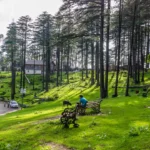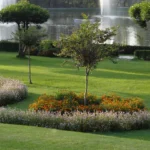Traditional Food of Kashmir
Table of Contents
Toggle- Overview
- The Essence of Kashmiri Cuisine
- Kashmiri Cuisine: Brief History
- Important Ingredients in Kashmiri Cuisine
- Popular Traditional Kashmiri Dishes
- The Wazwan: A Traditional Kashmiri Feast
- Conclusion: A Culinary Legacy of Kashmir
- How to book Kashmir tour online?
- People Also Ask
- What is Kashmiri cuisine?
- What is Wazwan in Kashmiri food?
- What are some popular Kashmiri dishes?
- What makes Kashmiri food unique?
- Is Kashmiri food spicy?
- What is the significance of saffron in Kashmiri cuisine?
- What is the best drink in Kashmiri cuisine?
- What is the difference between Kashmiri Pandit and Kashmiri Muslim cuisine?
- What are some common spices used in Kashmiri cooking?
- How is Rogan Josh prepared?
- What are Gushtaba and how is it made?
- What is Kashmiri Pulao and how is it different from other pulaos?
- Can you make Kashmiri food at home?
- What is Kashmiri Seekh Kebab?
- What is Shufta in Kashmiri cuisine?
- What is the role of Yogurt in Kashmiri food?
- Is Kashmiri food vegetarian-friendly?
- What are the health benefits of Kahwa?
- What is Yakhni in Kashmiri cuisine?
- How long does it take to prepare Wazwan?
- What is the best way to serve Kashmiri food?
- Are there any vegan options in Kashmiri food?
- What is the best time to enjoy Kashmiri food?
- Can you get Kashmiri food outside Kashmir?
- Inquiry Form
Overview
Very famous for its land, the heaven on Earth, another name for Kashmir sustains rich culture and traditions for centuries. These include Kashmiri cuisine-an iconic and diverse food itself in the whole of India. Traditional Kashmiri food mirrors the complex history of the region, the diversity of climate and kitchen innovations of its people. Known for aromatic flavors, unique cooking methods, and a blend of spices, Kashmiri food offers a delightful experience to those seeking a taste of the valley’s vibrant culture.
In this blog, we will discuss the traditional food of Kashmir, popular dishes, the region’s culinary history, and the distinct spices that define Kashmiri cuisine.
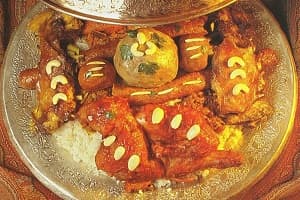
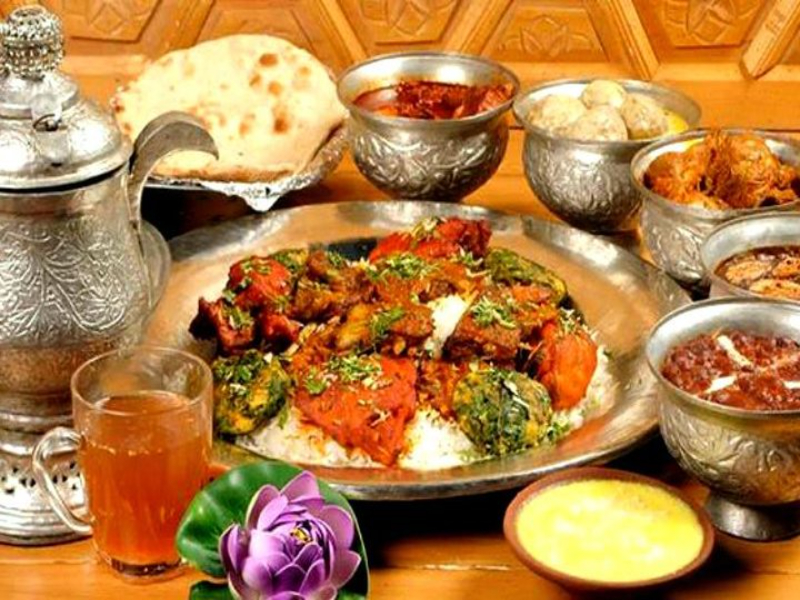
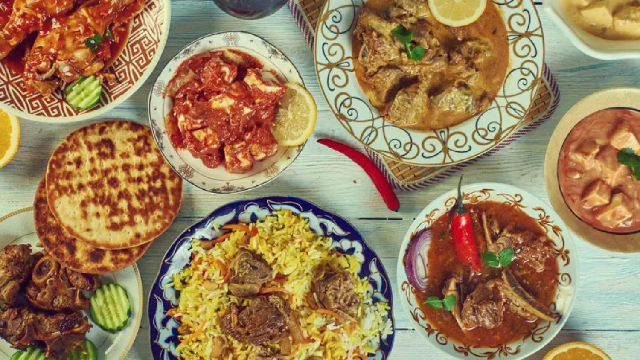
The Essence of Kashmiri Cuisine
Most influences are drawn through geography, culture, and historical elements of this valley. During historic times, different empires dominated the cooking culture of the food in Kashmir: Persian as well as the influence of the Mughals. The intake of rich spices, herbs, dry fruits especially almonds and saffron soon marked the popularity of Kashmiri dishes differentiating from other local cuisines.
The most characteristic flavoring elements in Kashmiri food are kesar (saffron), saag, mirch (red chili), dhania (coriander), and zeera (cumin). Slow-cooked techniques are also unique to Kashmiri food inasmuch as flavors come to be perfect over hours.
Kashmiri Cuisine: Brief History
The beginnings of Kashmiri cuisine have their roots back in the region’s ancient trade routes and cultural exchanges. Kashmiri food traditions have been affected significantly by the Mughals and Persians. They took the tradition of slow-cooked meat in rich gravies with them and adapted it to form a core component of Kashmiri cooking. One of the excellent examples of such influence is Wazwan-a traditional feast-intricately made different variety of dishes with the slow cooking of hours-long for flavor intensity.
Hindus, Muslims, and Buddhists eventually became part of the valley culture through their separate cuisines combined with the wealth of history about this region. Another important sector that is seen within the main landscape of culinary heritage is that of the vegetarian food of Kashmiri Pandits. This forms complexity and adds variety to this food.
Important Ingredients in Kashmiri Cuisine
Before diving into the popular traditional dishes, it’s essential to understand the unique ingredients that define Kashmiri food. Here are some key elements commonly used in the preparation of Kashmiri cuisine:
1. Saffron (Kesar): One of the most expensive and sought-after spices, saffron is grown in the fields of Kashmir. It adds color, fragrance, and a subtle flavor to many dishes, especially desserts like Kashmiri Firni.
2. Dry Fruits: Almonds, walnuts, and raisins are most commonly used for providing a rich texture and flavor to gravies, rice preparations, and desserts. It is mostly added to Wazwan items and biryanis.
3. Yogurt (Dahi): Yogurt is very largely used in Kashmiri food. It is most prominently used in Rogan Josh and Kashmiri Dum Aloo. Yogurt softens the meat and provides a rich creamy texture to the dishes.
4. Kashmiri Red Chili Powder: Kashmiri red chili powder is the pleasant, mild, and warm-appearing red chilies, which do not have a lot of heat in them but look so attractive that can transfer deep red color to food.
5. Wazwan Spices: The heart of many Kashmiri gravies and meat preparations lies in a mixture of aromatic spices, cinnamon, cloves, cardamom, and bay leaves.
6. Ghee: Ghee is the main medium of cooking, which gives richness to the flavor and smooth texture to the food.
Popular Traditional Kashmiri Dishes
- Rogan Josh
Rogan Josh is Kashmir’s most popular and favorite dish without a doubt. This is a fragrant lamb dish in rich yogurt, spice, and Kashmiri chilies gravy that color the dish deep red. It is very soft in texture and tender meat with a flavor of aromatic spices well served. This dish has Persian origins but has been adapted by Mughals. This dish is one of the quintessential ones in Kashmiri cuisine.
- Gushtaba
The second of the most acclaimed dishes of the Wazwan feast is Gushtaba. This is a rich gravy dish prepared from slow-cooked ground lamb or goat meat presented as soft, succulent meatballs. It is actually a thick and intense sauce of yogurt, cream, and spices. This is an intense and satisfying dish yet it is at the same time mild and subtle; its taste makes it one of the top highlights of any Kashmiri banquet.
- Kashmiri Dum Aloo
This is a great and delicious vegetarian delight, which is prepared with small potatoes in yogurt-based gravy flavored with tomatoes and absorption of aromatic spices. Kashmiri Pulao or Naan goes with this dish. Must try when vegetarians are having Kashmiri food. The whole richness of the gravy has drenched into its texture.
- Yakhni
Yakhni is a yogurt-based gravy dish prepared with lamb or chicken. The meat is slow-cooked in a rich broth with saffron, cloves, cardamom, and cumin. This is savory a bit sour but with the creamy richness of yogurt. The slow-cooked process lets the flavours seep into the meat, an unforgettable experience.
- Kashmiri Pulao
Kashmiri Pulao is the fragrant scented rice made with basmati rice, saffron, dry fruits, and flavorful spices. The aromatic flavor of ghee goes well with the sweetness of raisin in the prepared rice. It is normally served side with either meat or vegetable preparations. This pulao is one of the perfect sweet and savory flavors within itself and can frequently appear at Kashmiri feasts.
- Kahwa
The Kashmiri Kahwa is a traditional green tea made flavored with saffron, cardamom, and cinnamon. It is a warm and aromatic drink given to the guests as a welcoming drink. The Kahwa is also very famous for its immense health benefits as it aids digestion and boosts the immunity.
- Kashmiri Seekh Kebabs
It is probably one of the favorite street food and all flavors of minced lamb or chicken spiced up by a mix of Kashmiri herbs and spices. Marinated on a charcoal flame, it comes out very succulent kebabs which really taste wonderful if served with chutney or naan.
- Shufta
Shufta is a pudding prepared with dry fruits, almonds, walnuts, and raisins. Yogurt, sugar, and saffron are added to make it rich and creamy. This dish is mainly served on special occasions or festivals; hence, its sweet richness make it the perfect end to a grand Kashmiri meal.
The Wazwan: A Traditional Kashmiri Feast
Wazwan is a multi-course traditional meal of Kashmir prepared and served at marriages, parties, and other such celebrations. Wazwan represents Kashmiri culture and hospitality since there are more than 30 courses ranging from appetizers to main course to desserts. Wazwan is an event of the social category; the dishes are prepared by a Waza or chef with immense precision and care. Rogan Josh, Gushtaba, Tabakh Maaz, and Kashmiri Pulao are the popular courses of Wazwan.
It’s not just a feast but experiencing a part of the culture. It has been an art handed down to generations by the chefs of Kashmir. The Wazwan is that which reflects rich hospitality of Kashmir and is part of the celebration of food in Kashmir.
Conclusion: A Culinary Legacy of Kashmir
The flavors, techniques, and cultural influences are wonderfully woven into the traditional Kashmiri cuisine. This can be understood with the legend Rogan Josh and sweet fragrant Shufta, representing each dish telling the story of history of the valley, of immense cultural richness. Spices, yogurt, dry fruits, and saffron characterize it differently, but it makes the dishes rich in flavor because it is slow-cooked.
Whether you’re a meat enthusiast or a vegetarian, Kashmiri cuisine has something in store for everybody. The next time you go to Kashmir or happen to try out this delicious food, try all the delights this region has in store and the flavors that make Kashmiri cuisine a priceless heritage of Indian food.
How to book Kashmir tour online?
Contact Brown Chinar at +91 6005039532/+91 9906188874 or Email us at : Enquiry@brownchinarkashmir.com
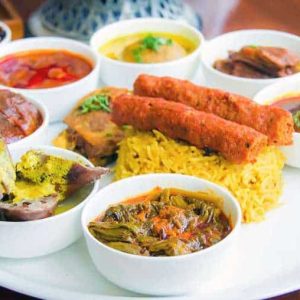
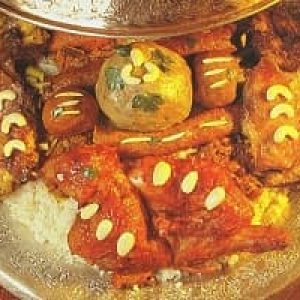
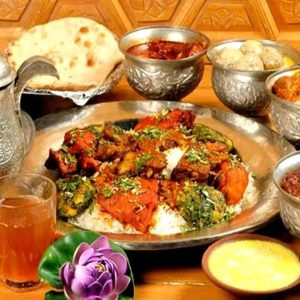
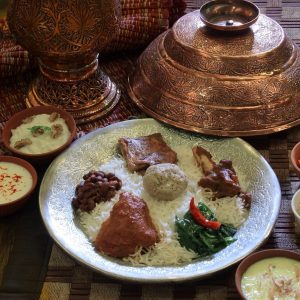
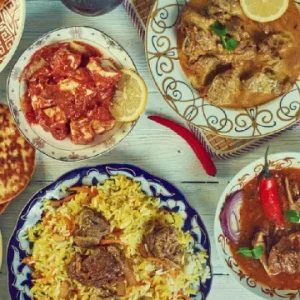
People Also Ask
What is Kashmiri cuisine?
Kashmiri cuisine refers to the traditional food of the Kashmir Valley, known for its rich flavors, aromatic spices, and slow-cooked meat and vegetarian dishes. It blends Persian, Mughal, and local influences, resulting in unique dishes like Rogan Josh, Gushtaba, and Kashmiri Pulao.
What is Wazwan in Kashmiri food?
Wazwan is a traditional Kashmiri feast that consists of a multi-course meal, typically served at weddings and celebrations. It includes a variety of meat and vegetarian dishes prepared with meticulous care by a Waza (chef). Some famous Wazwan dishes include Rogan Josh, Gushtaba, and Tabakh Maaz.
What are some popular Kashmiri dishes?
Popular Kashmiri dishes include Rogan Josh, Gushtaba, Kashmiri Dum Aloo, Kashmiri Pulao, Yakhni, Seekh Kebabs, and desserts like Shufta and Kashmiri Firni.
What makes Kashmiri food unique?
Kashmiri food is unique due to its use of aromatic spices like saffron, cinnamon, and cardamom, the liberal use of yogurt and dry fruits, and slow-cooking methods. It offers a balance of rich, spicy, and sweet flavors.
Is Kashmiri food spicy?
While Kashmiri food can be spicy, it is distinct from other Indian cuisines. The Kashmiri red chili powder provides a mild heat and a vibrant color to the dishes. It’s more about aromatic warmth than overpowering spice.
What is the significance of saffron in Kashmiri cuisine?
Saffron is a key ingredient in Kashmiri cuisine, adding color, fragrance, and flavor to dishes like Kashmiri Pulao and Kahwa. It is grown locally in Kashmir and is an essential part of traditional cooking.
What is the best drink in Kashmiri cuisine?
The best-known drink in Kashmiri cuisine is Kahwa, a warm, aromatic green tea infused with saffron, cardamom, cinnamon, and sometimes almonds or dried fruits. It is often served as a welcoming drink to guests.
What is the difference between Kashmiri Pandit and Kashmiri Muslim cuisine?
The primary difference lies in the use of ingredients. Kashmiri Pandit cuisine is predominantly vegetarian and avoids meat dishes like Rogan Josh and Gushtaba. Kashmiri Muslim cuisine, on the other hand, is more meat-based and incorporates richer gravies. Both styles feature similar spices and cooking methods but focus on different types of dishes.
What are some common spices used in Kashmiri cooking?
Kashmiri cooking uses a wide range of spices, including cinnamon, cardamom, cloves, bay leaves, cumin, and Kashmiri red chili powder. Saffron and dried ginger (sonth) are also used extensively for their distinct flavors.
How is Rogan Josh prepared?
Rogan Josh is prepared by simmering lamb in a rich, flavorful gravy made from yogurt, saffron, and a blend of aromatic spices. The dish is slow-cooked to allow the meat to absorb the deep flavors, resulting in tender, flavorful lamb.
What are Gushtaba and how is it made?
Gushtaba is a dish of meatballs made from ground lamb, simmered in a creamy gravy. The gravy is made with yogurt and a mix of spices like cardamom and cinnamon. These tender meatballs are a centerpiece of the Wazwan feast.
What is Kashmiri Pulao and how is it different from other pulaos?
Kashmiri Pulao is a fragrant rice dish made with basmati rice, saffron, dry fruits like almonds and raisins, and a blend of spices. Unlike other pulaos, it has a mild sweetness and is often served with rich meat dishes.
Can you make Kashmiri food at home?
Yes, you can make Kashmiri food at home with the right ingredients. Many of the key ingredients like saffron, Kashmiri red chili powder, and yogurt can be found in most grocery stores or online. The dishes may require patience and time, especially slow-cooked ones like Rogan Josh and Yakhni.
What is Kashmiri Seekh Kebab?
Kashmiri Seekh Kebab is a type of skewered meat made from minced lamb, spiced with Kashmiri herbs and grilled over an open flame. The kebabs are juicy, flavorful, and commonly served as a street food snack.
What is Shufta in Kashmiri cuisine?
Shufta is a traditional dessert made from a mixture of dry fruits like almonds, raisins, and walnuts, combined with yogurt and sugar. It is flavored with saffron and is typically served during festivals or special occasions.
What is the role of Yogurt in Kashmiri food?
Yogurt is used extensively in Kashmiri cuisine to tenderize meats, balance spices, and create creamy gravies. It’s a key ingredient in dishes like Rogan Josh, Yakhni, and Kashmiri Dum Aloo.
Is Kashmiri food vegetarian-friendly?
Yes, Kashmiri cuisine offers many vegetarian dishes, especially within the Kashmiri Pandit tradition. Dishes like Kashmiri Dum Aloo, Haak, and Kashmiri Pulao are completely vegetarian and delicious.
What are the health benefits of Kahwa?
Kahwa is known for its health benefits. It aids in digestion, boosts metabolism, and has antioxidants from the green tea and saffron. The spices also help improve immunity and promote overall well-being.
What is Yakhni in Kashmiri cuisine?
Yakhni is a yogurt-based meat dish, often made with lamb or chicken. It is simmered in a flavorful broth with saffron, cumin, and cardamom. The result is a rich, creamy dish with a subtle tang from the yogurt.
How long does it take to prepare Wazwan?
Preparing a Wazwan can take several hours, as it involves slow-cooking multiple dishes to perfection. The process of marinating, simmering, and arranging the multi-course meal requires time and attention to detail from skilled chefs known as Waza.
What is the best way to serve Kashmiri food?
Kashmiri food is best served hot and fresh, often accompanied by steamed rice or Kashmiri Pulao. Dishes like Rogan Josh and Gushtaba are served with flatbreads like Naan or Sheermal, while lighter dishes like Kahwa are enjoyed as a refreshing beverage.
Are there any vegan options in Kashmiri food?
While Kashmiri cuisine is predominantly known for its meat dishes, there are vegan-friendly options available. Haak (a type of collard greens cooked in spices), Kashmiri Dum Aloo, and Kashmiri Pulao can easily be adapted to vegan preferences by omitting dairy or ghee.
What is the best time to enjoy Kashmiri food?
Kashmiri food is ideal for enjoying during colder months, especially during winters when the hearty, slow-cooked dishes provide warmth. The Wazwan is often prepared during festivals, weddings, and other celebrations, making it a perfect feast for special occasions.
Can you get Kashmiri food outside Kashmir?
Yes, Kashmiri food has become popular across India and abroad. Many restaurants and food festivals offer authentic Kashmiri dishes in cities like Delhi, Mumbai, and Bangalore. Online delivery services also bring these delicacies to people around the world.

